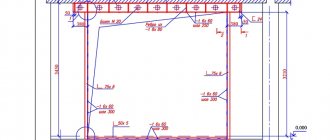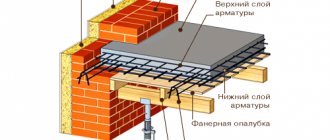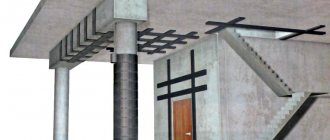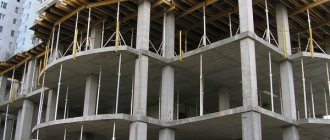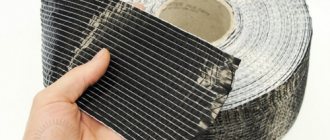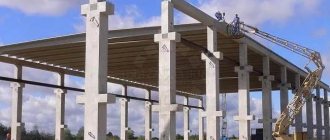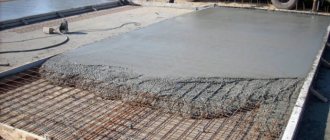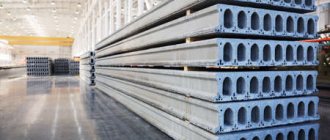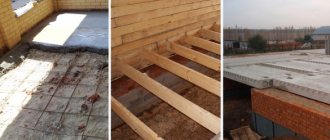Strengthening reinforced concrete floors
Strengthening reinforced concrete floor slabs and coverings is a complex engineering and technical process that requires high professionalism of craftsmen. In each specific case, we develop a design plan for strengthening structures that meets the requirements of SNIP and aesthetic characteristics. KSK Construction specialists have several proven, significantly different methods that successfully solve two main problems:
- Transferring part or all of the load to the reinforcement structure;
- Increasing the load-bearing capacity of previously existing architectural components.
The construction of office buildings using prefabricated technology from metal structures, which has become popular and economical in recent years, requires reconstruction after long-term operation. We will strengthen monolithic reinforced concrete floors:
- By building up a monolithic layer on top with the installation of reinforced concrete dowels;
- By building up a monolithic layer on top in the form of a ribbed slab;
- By building up a monolithic layer on top while ensuring adhesion of surfaces;
- By building up a monolithic layer on top with insufficient adhesion of surfaces;
- Creating continuities in the built-up floor;
- Bringing metal unloading beams from below.
Strengthening monolithic beamless floors, as a rule, is required when reconstruction of an administrative building and other buildings with floors in the form of smooth slabs resting on capitals is carried out. We carry out strengthening in the most cost-effective way from those presented:
- Replacing the existing floor with a new one;
- Reconstruction of the existing floor into slabs supported along the contour;
- Reconstruction of an existing floor into beam slabs;
- Extension from above with the installation of dowels;
- Reinforced concrete extension device in the form of a coffered slab;
- Complete unloading of the existing floor with beams made of rolled metal.
The service life of interfloor ceilings is much lower than that of walls and foundations. Reinforcing interfloor floors with reinforced concrete from above will make it possible to install floors without dismantling the old ones. By fixing metal reinforcement into the main walls and pumping in the concrete mass, we get a new reinforced concrete floor with significantly increased load-bearing capabilities.
We reinforce the concrete floor using concrete on top and bottom. If the ceiling, in addition to the walls, also rests on beams, then we strengthen them too
We pay special attention to the strength of adhesion of new concrete to old
Strengthening hollow-core floor slabs requires sealing void channels. Especially if longitudinal cracks are formed between the voids.
It is possible to transform a hollow-core slab into a monolithic structure by strengthening the hollow-core floor by additionally reinforcing some of the voids with flat metal frames and then filling them with concrete.
Strengthening floor beams
The failure rate of a building largely depends on the condition of the floor beams, which are subject to large load-bearing loads. Our expert will help you figure out exactly how to strengthen the floor beams of your facility, taking into account the degree of wear, room requirements and working conditions.
Strengthening lintels and floor beams has been repeatedly tested by the company's practice and consists of the following main methods:
- Increase in section;
- Metal reinforcement;
- Installation of prostheses;
- Reducing the span;
- Reducing the step;
- Strengthening rafters.
Local or general strengthening of metal floor beams by installing overlays and ribs or tightening along the lower chord using trusses are simple, affordable and very effective methods of strengthening. The construction of hangars and other prefabricated buildings from metal structures involves the initial strengthening of floor beams.
Property owners can determine for themselves that it is time to start strengthening wooden floor beams with overlays or other methods by the vibrations and creaking that appear. Installing wood overlays with a thickness of at least 50 mm on the weakened area will help solve the problem. Before installation, be sure to treat the beams with antifungal drugs, and use jacks to minimize the resulting deflection. Through-the-hole bolts and studs securely hold the structure in place.
In addition to traditional methods, KSK Construction widely uses carbon fiber reinforcement of floor beams. Carbon fiber fixed with epoxy glue in several layers gives the wooden structure the strength of metal!
Preparation of components for carbon fiber reinforcement
Carbon materials are supplied wound and packaged in polyethylene. It is very important not to stain them with dust, of which there will be a lot of dust after grinding the concrete, otherwise the carbon fiber will be impossible to saturate with the binder , i.e. This will result in a manufacturing defect. Therefore, the procurement area should be covered with dense polyethylene and the required length of carbon material should be unrolled along it. Cutting carbon tapes and meshes can be done with a stationery knife or metal scissors, and carbon lamellas can be cut with an angle grinder with a metal cutting wheel.
Adhesives are usually used in two components – i.e. it is required to mix two materials in a certain proportion. It is necessary to strictly follow the manufacturer's instructions and use scales or measuring cups when dosing . Mixing of the compositions occurs by gradually adding one component to another with constant stirring with a low-speed drill. Dosing errors, or incorrect mixing of one component with another, can lead to boiling of the adhesive .
In recent years, most manufacturers have been supplying adhesives in kits - i.e. in two buckets with already dosed volumes of components. In this way, you can simply mix the contents of one bucket into another (the bucket is specially supplied with a larger volume (half empty)) and get a ready-made adhesive composition.
Polymer cement adhesives (for carbon meshes) are supplied in bags and sealed with water according to the instructions, like any repair material.
It should be remembered that the adhesive has a limited lifespan - about 30-40 minutes, and it is sharply reduced when the temperature rises above 20 ° C, so the volume of the prepared adhesive should not exceed the physical capabilities of its production.
Features of materials
Wooden floors are environmentally friendly, durable, and weigh relatively little. The beams are easy to cut, adjust, and process. Coniferous wood is better able to withstand bending loads. An additional advantage is low cost. Their price is less than the cost of steel and concrete analogues. You can lift the beams up without using special tools.
On the other hand, wood is susceptible to rotting and drying out. During reconstruction, such beams need to be completely replaced.
Floors made of polymer materials in combination with concrete perfectly insulate sound and retain heat. Reconstruction using them is possible at any time of the year. There is no need to treat the finished surface with plaster.
Reinforced concrete structures are made using steel beams and reinforcement. They do not burn and insulate noise and warm air well. Withstands the heaviest loads. Can be manufactured at the reconstruction site. The disadvantage of this type of floors is the significant weight that creates a load on the foundation of the house.
Strengthening monolithic and hollow core slabs
A monolithic ceiling is a non-demountable horizontal system in the form of a monolithic slab of various shapes and designs.
The main functions of monolithic floors: ensuring the resistance of the structure to vertical loads from everything in the room; formation of structure rigidity due to horizontal linking of supporting walls; zoning or limiting the height of rooms by forming a visible, strong vertical boundary
Hollow core slabs are rectangular reinforced concrete panels of regular shape with longitudinal channels, parallel to which reinforcement (steel ropes) is laid.
The holes come in different configurations: cylindrical, pear-shaped, rectangular. Their design is much lighter than solid slabs, but this does not reduce their strength and reliability.
The load-bearing properties of the slab are not affected by the number of voids and their location.
On the contrary, the presence of air cavities in a concrete product increases its heat and sound insulation characteristics.
Application area
These slabs are used to strengthen the load-bearing capacity according to the normal section, taking into account the effects of static or seismic loads. Areas of application include buildings for various purposes, namely public, cultural, industrial or domestic.
Methods for strengthening floors
1. The lower plane of the floor slab along the entire length of the longitudinal direction is covered with solid tapes made from composite horizontally directed material FibArm Tape.
In this case, the step size in width is greater than the height of the slab multiplied by 2. The number of layers is calculated based on the load-bearing capacity data. 2.
Installation methods
For strong adhesion to the surface of reinforced structures, special adhesive compounds are used. Gluing tapes and lamellas can be done in different ways. For these elements, a distinction is made between “dry” and “wet” installation methods.
The “dry” version differs in that carbon fiber is first placed in the desired area, and then it is impregnated with an adhesive composition. The adhesive is pressed inwards using a paint roller or spatula.
The use of the “wet” installation technique means that the reinforcing element is coated with an adhesive compound before it is placed. The common point for both methods is the impregnation of the base with adhesive. Carbon meshes are attached only using the “wet” method. Therefore, they are often incompatible with tapes and lamellas.
When reinforcing reinforced concrete structures with carbon fiber, it is important to thoroughly prepare the surface beforehand. Moreover, no action is taken until the workers complete the so-called marking of the structure. It is necessary to outline problem areas, which will be cleaned a little later, freed from all kinds of contaminants, that is, prepared for the installation of carbon fiber. Sandblasting machines or grinding machines with diamond working cups are used.
Benefits of use
In general, two properties of carbon fiber are interesting for construction. The first - structural versatile reinforcement - is used to give the material increased hardness and compressive strength. The structure is reinforced with fiber 5–10 microns thick with different fiber lengths. It makes sense to structurally strengthen the finishing surfaces and supporting structures of buildings.
The second purpose of carbon fibers in the construction industry - embedded reinforcement - is performed by additionally processed primary fiber, which takes the form of canvas, roving, threads, ropes and rods reinforced with polymer resins. In this case, carbon fiber does not strengthen the filler itself as a whole, but serves as a reliable, tear-resistant base for it.
But what are the benefits of carbon fibers, and why should they be preferred to less exotic materials? Let's start with the fact that in terms of physical and chemical properties, the closest competitor to carbon fiber is glass fiber, which is quite widespread in the form of fiberglass for interior plastering work. However, glass has a much lower tensile strength and is heavier, while carbon polymer is not only strong, but also adheres much better to the surrounding solid material due to its high intrinsic adhesion.
The cladding and structure reinforced in this way are also characterized by increased shear and torsional strength, which has always been a significant problem for steel, glass and other synthetic materials.
However, it is not without complications. In particular, when interior finishing of buildings, the question of the fire safety of carbon fiber is raised. In the presence of oxygen, it burns out at temperatures of about 350–400°C, but being “preserved” in an airless environment, carbon retains its properties even when heated above 1700°C. Higher heat resistance is guaranteed by fiber and its derivatives coated with various types of carbides - this must be taken into account when choosing a material for finishing work.
Carbon fiber is a material of the future, from the past
The material was discovered by Thomas Edison in 1880 as part of his research on incandescent lamp filaments. In the last 10 years, at the instigation of foreign colleagues in the form of supplies of expensive carbon fiber products, domestic developers and manufacturers have begun resuscitating hydrocarbon projects begun during the Soviet period in all areas.
Everyone knows that carbon is needed in every form, in every industry. This is the production of literally everything that is not made of metal, glass, wood or concrete. But its main advantage is that it can not only complement traditional materials, but also replace them with benefits for humans and nature.
Video report on Russian carbon fiber production
A little history: how carbon appeared
Today, carbon in one form or another is in demand in almost all industrial sectors. Its peculiarity and main advantage is that it is able to harmoniously complement traditional building materials, be it glass, metal, wood or concrete, or even replace them, which is very beneficial for both humans and nature.
Carbon was discovered back in 1880 by T. Edison while studying the filament of an incandescent lamp. Thanks to foreign manufacturers and industrialists, carbon fiber has become actively used in various industries, including construction. In our country, the latest projects using carbon fiber were developed back in Soviet times, which is why they are now being actively revived by engineers.
Advantages of using carbon composites
Carbon fiber composite products for construction are superior to traditional steel and concrete products in all operational properties: with the same strength, they are tens of times lighter.
The canvas, impregnated with hardened resin, is only 3 mm thick, stronger than technical plywood with a thickness of 15 mm.
- Weight quality
- High strength
- Resistance to aggressive chemical environments
- High specific hardness
Using carbon fiber mesh instead of steel reinforcement reduces the weight of wall panels by 75%
External reinforcement of reinforced concrete, wood and brick structures with carbon fiber increases the strength of structures by more than 100%
Tensile strength, MPa Tensile modulus of elasticity, GPa Elongation at break, % Density, g/cm3 Carbon (based on PAN precursor) high-strength with standard modulus 3500-5000 200-280 1.4-2.0 1.75- 1.80 high-strength medium modulus 4500-7000 280-325 1.7-2.1 1.73-1.81 high modulus 3500-5000 325-450 0.7-1.4 1.75-1.85 ultra-high modulus 2500-4000 450-600 0.7-1.0 1.85-1.95 Glass E-glass 2500-3800 70-75 4.5-4.7 2.5-2.7 S-glass 4000-4500 80-90 5.0-5.3 2.5 Organic Aramid 3000-3600 60-180 2.4-3.6 1.45 Polyethylene 200-3000 5-170 3-80 0.96 High-strength steel 1200-2800 200 3.5 7.8 stainless 800-2000 190 3.0 7.8 Basalt 3000-4800 90-110 3.0 2.6-2.8 Boron 3500-4000 350-400 0.5-0.7 2.6
What to do if the columns are overloaded
Many experts who have had to deal with the restoration of slabs believe that such methods in most cases do not completely solve the problem. They can be used when strengthening compressed columns that coincide with the projection of the working reinforcing bars of the frame. In this case, the columns are wrapped with bundles in several layers.
The harnesses are made of carbon fiber. If there are no harnesses, use strips of the same fabric. When using a set of these measures, the load-bearing capacity of the entire structure increases.
The slabs of any building are constantly under tension. They are acted upon by mechanical, statistical and dynamic forces. Additionally, they are destroyed by unfavorable environmental conditions and exposure to various chemicals. Therefore, examining their condition and determining the strengthening method is a responsible job.
The procedure for carrying out work on strengthening slabs using carbon fiber reinforced plastic
Work to restore the load-bearing capacity of floor slabs is carried out by specialized construction and repair organizations that have the ability to make technical calculations and specialists in creating reinforcement projects.
Main stages of work:
- Analysis of the causes of damage and the condition of floor slabs. Drawing up a damage diagram.
- Development of a repair and strengthening project. The project contains calculations using the finite element method using special software that simulates the situation before and after repair work. Based on the model, the number of layers, laying pattern (transverse layers of carbon fiber may be needed) and type of carbon fiber (width, density, single or bidirectional carbon fiber threads in the fabric) are selected.
- Drawing up and coordination of the strengthening project with the departments of the State Construction Committee and the owner of the building project.
- Drawing up estimates and work schedules.
- Removing a single layer floor or covering.
- Unloading the slab using jacks.
- Preparing the surface for laying fabric or tape. If necessary, the damaged layer is removed, cutting is carried out, and the working area is cleaned of dirt, dust and rust. Laying a repair layer from compositions with a high “setting” speed to reduce the time required to complete the work. In case of serious damage, use a carbon fiber reinforcing mesh (e.g. CarbonWrap Grid 300/1200).
- Laying layers of carbon fiber on a prepared, dust-free and primed surface according to the approved scheme and sequence. In industrial and commercial buildings with a large floor area, monolithic slabs with crossbars are used. The crossbar is repaired and a reinforcing carbon fiber tape is placed on it from the side of the crossbar, extending onto the surface of the slab.
- If necessary, make cosmetic repairs or restore the floor covering.
- Handing over the work to the customer.
Repair work is carried out in a dry room at a surface temperature not lower than +5° C and humidity not more than 4%. The next layer is laid after 2…3 hours, depending on the polymerization conditions of the epoxy adhesive. If there is high humidity, the room should be dried.
Advantages of reinforcing monolithic or hollow-core floors:
- Laying fabric, tape or laminate does not require additional structures or special equipment. Most work is carried out from scaffolding.
- Short deadlines for completing work. Pasting can be carried out 6…12 hours after repair work, i.e. gaining 60...70% strength of the repair mixture based on epoxy resin.
- The thickness of the reinforcing layer affects the thickness of the slab slightly. When performing reinforcement from the floor or ceiling, finishing work solves unevenness issues. The lead time for completing the work is 2…5 working days.
- Cost of reinforcement with carbon fiber, expressed per square meter. meter, taking into account the costs of materials and wages of workers, it turns out to be lower than traditional methods of reinforcement.
Strengthening concrete monolithic and hollow-core floor slabs using composite materials based on carbon fiber and epoxy compounds has significant prospects, but is hampered by the lack of regulatory documents on strength calculation methods and materials.
How to strengthen the overlap
More often than others, reinforcement with carbon fiber is used for floors. For this element, it is very important that the carbon material does not add additional load due to its weight, and protects against corrosive destructive processes. It also does not change the geometry of the object, since the thickness of the canvas is 1-5 mm.
Reinforced overlap in this way will last a long time. It is very easy to install, you just need to glue and secure the canvas. It does not require additional labor in the form of a large team of workers or bulky equipment.
How to reinforce floors:
- The first step is to carefully inspect the element and analyze it for the presence of weak areas that require strengthening. Any dents and cracks are subject to scrupulous examination.
- After identifying the shortcomings, it is necessary to begin creating a project to strengthen the weakened areas.
- Then the final estimate is formed.
- If necessary, the surface of the ceiling is leveled. All defects, including cracks, are sealed with a cement composition. After hardening, they are sanded to create a perfectly flat plane. The final stage is getting rid of excess dust and other particles. This is important for better bonding of the adhesive to the surface.
- Markings are drawn at the location where the future carbon tape will be attached. You should not avoid this point; it is important to attach the fiber carefully. All stages of installation were discussed in more detail in the chapter “Installation of carbon fiber to reinforce concrete.”
- Finally, sprinkle with quartz sand for the most reliable connection.
Reinforcement when creating or enlarging openings in floors and walls
Quite often, problems of strengthening structures arise when constructing openings in ceilings and walls. Often, openings in the ceilings are made for the installation of stairs in two-level apartments, in the walls - when moving or enlarging doorways.
As a rule, the traditional solution for strengthening floors is to install metal beams, which is quite complex due to the need to create support zones for beams in the walls, the large weight of structures, ensuring reliable connection of the floor to the beams, and due to the reduction in the construction volume of the interior.
An example of the effective use of the external reinforcement method is the strengthening of a 3.4 x 3.8 m opening in a two-level apartment of one of the residential buildings in Moscow, cut out in the ceiling for a staircase. Computer modeling of the stress-strain state of the floor in the presence of an opening revealed a significant change in the nature of its operation. According to the calculation results, strips of carbon fabric were glued to zones of dangerous concentration of tensile stresses on the lower and upper surfaces of the slab (Figure 4).
Figure 4. Strengthening the interfloor slab with an opening
An alternative solution was to place metal I-beams under the ceiling, which created great difficulties for builders in delivering and installing beams in the finished room and at the same time reduced the construction volume of the lower room (due to the installation of a suspended ceiling 35 cm below the floor surface).
In a similar way, load-bearing walls and ceilings were strengthened during the redevelopment of another residential premises. The construction of openings in load-bearing transverse walls led to a change in the operation of these walls and ceilings in the area of the openings. In order to prevent the possibility of unacceptable deformations along the contour of the openings and adjacent floor areas, carbon fiber overlays were made (Figure 5).
Figure 5. Reinforcement schemes: a - rectangular opening, b - arches
Protective coatings
Adhesive made from epoxy resins is flammable. Under ultraviolet exposure, it also risks becoming very fragile. Therefore, such compositions must be used with the intended fire protection of objects that are to be strengthened.
In general, strengthening a structure with carbon fiber is a progressive, and from many points of view, economical way to strengthen a structure and its elements. The composites used for reinforcement are much lighter and much thinner than more conventional materials. In addition, external reinforcement is a universal modern technique. It is used both at the construction stage of a building and during repairs and restoration work, that is, to strengthen the structure, in many cases there is not even a need to suspend its operation.
Carbon fiber reinforces elements of residential and industrial buildings, architectural structures, transport and hydraulic facilities, and even nuclear industry facilities.
Well, those who believe that the use of new materials and technologies is always more expensive than traditional solutions are a priori mistaken in their calculations. The strength of structures increases significantly, the building does not cease to be used during repairs (and this could cause financial losses of more serious proportions), and such repairs are very quick in time.
You can learn how to reinforce boards with carbon fiber from the video below.
Carbon fiber reinforcement
The original type of carbon fiber is the finest microfiber, suitable for reinforcing both monolithic concrete and epoxy gelcoat. The fiber thickness is 5-10 microns, the length of the fibers is different. Both finishing surfaces and load-bearing elements in the array are reinforced with carbon fiber.
As for embedded reinforcement, it is carried out in construction “traditionally” - with recycled carbon fiber products: carbon textiles of various types, canvases, roving, rod reinforcement on polymer resins. The last option is an example of how carbon fibers work not as micro-reinforcement for a load-bearing element, but for reliable fastening and fixation. In terms of strength (including shear and torsion) and fixation, carbon fiber fiber is many times superior to glass, polymer and metal.
Reinforcement of flooring with carbon fiber
The ceiling, just like any other load-bearing structure of a building, can be reinforced with a mesh, lamella or carbon fiber tape using the sticking method in the stressed zone (according to calculations, but most often this is the lower edge of the slab in the center of the span). The purpose of reinforcing the floor is to increase the load-bearing capacity for bending moments. This also applies to prefabricated elements - both monolithic and hollow-core slabs are reinforced using similar technology. In the support zones for floor elements of any type, the development of inclined cracks is minimized - for this, carbon tapes or meshes in the form of U-shaped clamps are used. It is possible to strengthen not only reinforced concrete, but also metal and wooden floors.
Reinforcing wooden beams with carbon fiber
Wooden elements can be reinforced by wrapping them with carbon fabric, roving, carbon fiber of any kind - in the form of tapes, flaps, fragments in the most loaded areas. In particular, this is the support unit and the central stretched section of the beam, and in wooden rafter systems - connections and fixation of arches and trusses to the rafter beam (mauerlat). Pasting is performed using epoxy resins that also contain carbon microfiber.
Carbon Fiber Putty
Acrylic paints, Venetian decorative plaster, polymer flooring are all examples of excellent, aesthetic and fashionable finishes. But without reinforcement in the mass, many decors are too fragile and fragile, so the use of carbon fiber as fiber, as well as securing the joints and seams of panels and claddings for painting using carbon fiber textiles (tape, canvas) is an ideal solution. Carbon fabrics are used both for finishing and for leveling walls during plastering. A separate wide area of application is auto tuning and repair.
External carbon fiber reinforcement
External reinforcement systems (ERS) are used for all types of building structures and for almost all building materials (wood, reinforced concrete, metals, stone). The purpose of external reinforcement during restoration and reconstruction is to eliminate the consequences of corrosion and destruction due to natural negativity and long-term operation. SVA is also promising in seismic engineering. The external reinforcement technique makes it possible not to change the structure and design of structures; in essence, it is surface reinforcement with super-strong carbon meshes, fabrics, lamellas and other carbon fiber-based products.
During new construction, the SVA includes wrapping the load-bearing element (beam, reinforced belt, stand, tape, etc.) with a carbon sheet or thick roving, then pouring a protective layer of concrete on a thin filler (fine quartz sand). One of the advantages of the method is the almost complete elimination of corrosion of internal steel reinforcement: external reinforcement and a protective sand-concrete layer encloses the element in a strong cage. But the main goal of SVA is to increase the strength and reduce the weight of building structures and elements.
We use modern technologies
Recently, there have been experimental attempts to replace metal reinforcement when reinforcing the floor with carbon fiber or carbon fiber reinforced plastics. Indeed, materials, mainly cords and fabrics based on carbon fiber or Kevlar, used in the manufacture of body armor, have even higher tensile strength than traditional metal reinforcement.
Where is it better to apply
The use of such materials must be subject to certain requirements:
- the surface of the building element must be perfectly leveled (down to fractions of a millimeter);
- the glue must be selected so that it creates the necessary adhesion (cohesion) between the surfaces to be glued and is chemically neutral to their structure;
- ensuring reliable protection of the structure during subsequent operation (materials such as carbon fiber are difficult to tear, but easy to cut).
Reinforcement methods depending on the type of structure
Prefabricated and monolithic floor slabs:
- Installation of concrete slabs with reinforcement (extension from above), extension from below
- Summing up longitudinal and transverse metal beams
- Reinforcement with 2 cantilever inserts from channels and I-beams
- Reinforcement by embedding channels and voids
Reinforcement of overlap with carbon lamellas
Cover and floor beams:
- Rigid unloading structures (reinforced concrete and steel beams, frames)
- Flexible prestressed metal beams, trusses, brackets
- Hinge-rod chains
- Construction of enclosing structures with the addition of reinforcement
- Construction of jackets with the addition of reinforcement
- One- and two-sided extensions
- Installation of metal racks
- Trusses and trussed metal systems
- Additional prestressed reinforcement
- Prestressed horizontal, truss or combined tightening
- Prestressed inclined ties
Strengthening crane beams:
- Construction of a layer of reinforced concrete
- Building up a shelf with reinforced concrete
- Device of a horizontal steel belt to absorb horizontal forces
- Reinforcing the column with steel elements
Centrally and eccentrically compressed columns:
- Reinforced concrete frame or jacket
- Extension with reinforced concrete
- Prestressed spacers
- Metal clip
- Reinforcement of consoles with steel parts
Modern reinforcement methods involve the use of specialized materials, such as high-strength repair mixtures and composite materials for external reinforcement of structures. The use of composites (fiberglass and carbon fiber) makes it possible to solve most reinforcement problems with greater efficiency compared to traditional methods. And the high technology of work gives a significant advantage in the speed of work completion.
The company “Strengthening Technologies” offers services for the repair, reconstruction and strengthening of buildings and structures with composite materials. The company's engineers carry out preliminary calculations of the project, visit the site and prepare design documentation.
To receive a free consultation and call a specialist to the site, please contact:
To improve the condition of the floors, use
- wooden overlays;
- metal rigid profile, rods, strips;
- carbon fiber extension.
Wooden overlays are used to reinforce timber floor beams. The dentures are made to their full length and are fixed on opposite sides, from top to bottom (left to right) with strip steel clamps.
Metal profiles, strips or rods are used in the same way as wooden overlays.
Carbon fiber extensions are the most popular restoration option. The material is lightweight, durable, fire-resistant, resistant to temperature changes, fungi, and corrosion.
The type of carbon fiber reinforced plastic (plates, strands or tapes), the thickness of the layer is selected depending on the type of floor, as well as the design load. Carbon fiber is universal, used to reinforce metal floor beams, and used for repairing wooden and reinforced concrete surfaces.
Do you need to check the condition, reinforce the beams with carbon fiber, or install intermediate supports? Contact the construction company. Our specialists will carry out all the preparatory work and quickly and efficiently restore the floors.
Professionalism
The entire staff of the Company are high-altitude workers with extensive work experience and have the appropriate education. The company has all the necessary approvals, permits and certificates for performing high-altitude work.
We take on any high-altitude work
We are Always Ready to Provide Free Competent Technical Consultation and Calculate a Project on Any Issue Related to Industrial Mountaineering.
Thanks to our extensive experience in various areas of construction, our Company can solve problems of varying complexity.
Safety
Annual Recertification of Specialists, Medical Examination, Step-by-Step Instruction, Use of Protective PPE.
